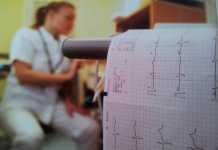A nuclear cardiac stress test administered shortly after a coronary angioplasty with stent implantation may give important clues to whether the procedure was successful or whether the patient will experience restenosis (recurrent narrowing of the arteries), requiring additional procedures or surgery. The study results were reported in the December issue of The Journal of Nuclear Medicine, published by the Society of Nuclear Medicine (SNM).
"Thirty patients who underwent percutaneous transluminal coronary angioplasty (PTCA) with stent implantation, after the procedure and underwent a cardiac stress test within a week of it. The study authors reported that 17% of the patients (five) who had the stent implantation still had myocardial ischemia (lack of blood and oxygen to the heart) early after the procedure, as assessed by cardiac stress testing. Detecting residual myocardial ischemia is important because it is associated with a high rate of restenosis, which was found in this study population. Twenty-three patients underwent follow-up angiography to determine if there was restenosis. Overall, 26% of these patients with angiographic follow up had restenosis. Of those who had early, identified problems, 75% experienced restenosis of the stented area versus only 16% of those whose studies had not shown any defects. Four patients (13%) underwent target lesion revascularization, ie, an additional balloon or stent angioplasty procedure or coronary bypass surgery to clear up recurrent blockages. Half of these restenotic events took place in patients with residual ischemia after stent implantation.
In addition to identifying patients at risk of restenosis, the study also confirmed the efficacy of angioplasty with stent implantation versus coronary balloon angioplasty. The latter has been reported as between 30% and 50% residual abnormalities after the procedure, compared with the 17% rate found in this study after PTCA. In 1998, approximately 539,000 Americans underwent PTCA.
During a typical nuclear cardiac stress test, individuals are injected with a radiotracer, and single-photon emission computed tomography (SPECT) images are taken while the patient is at �rest.� They then exercise on either a bicycle or treadmill and are injected with a second radiotracer dose. A second set of SPECT images records how the heart works while �stressed.� In individuals for whom physical exercise is inappropriate, dipyridamole, which mimics the heart�s action when exercising, is given to the patient.
Cardiac stress tests are used to track the amount of blood flow (myocardial perfusion) in heart muscles and to identify areas in which blood and oxygen flow may be lacking. They also determine how well the heart muscle is pumping. Frequency and Clinical Significance of Myocardial Ischemia Detected Early After Coronary Stent Implantation was written by Josep Rod�s-Cabau, MD, Jaume Candell-Riera, Enric Domingo, Joan Castell-Conesa, Inocencio Anivarro, Juan Angel, Santiago Aguad�-Bruix, Ferran Padilla, Adriana Soto, and Jordi Soler-Soler of the Servei de Cardiologia and Servei de Medicina Nuclear, Hospital General Universitari Vall d�Hebron, Barcelona, Spain.
Continue Reading Below ↓↓↓
Source: Society of Nuclear Medicine









